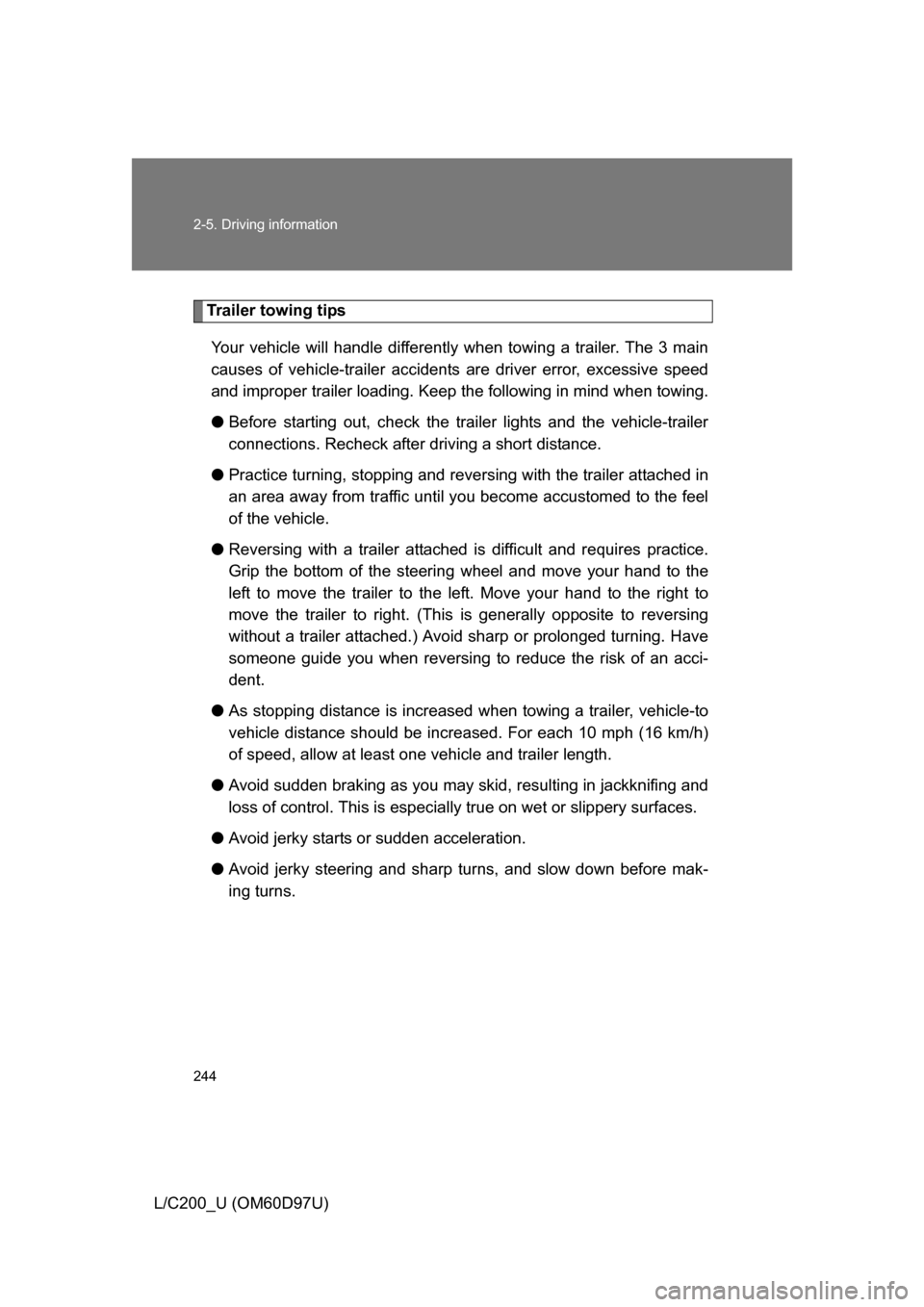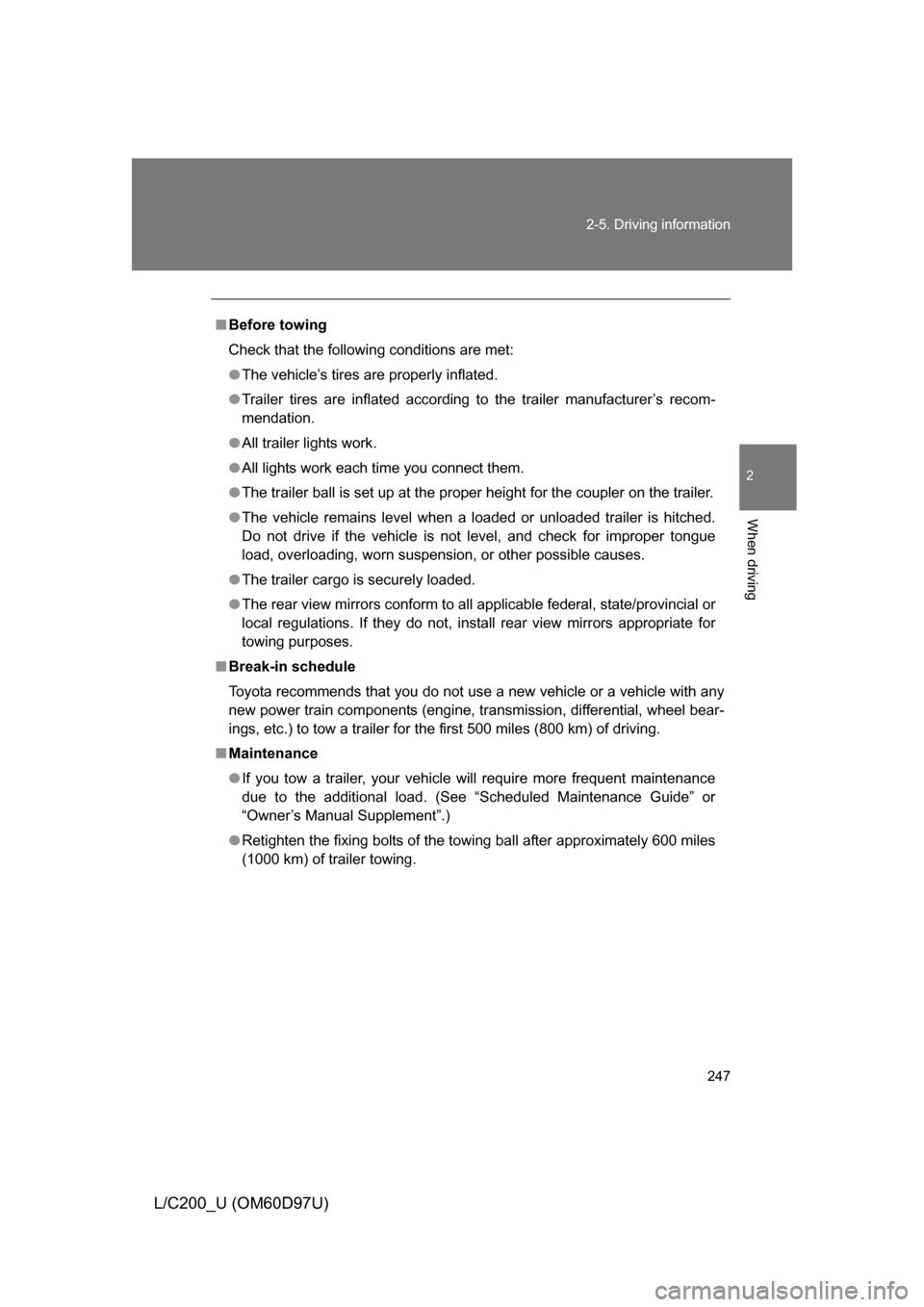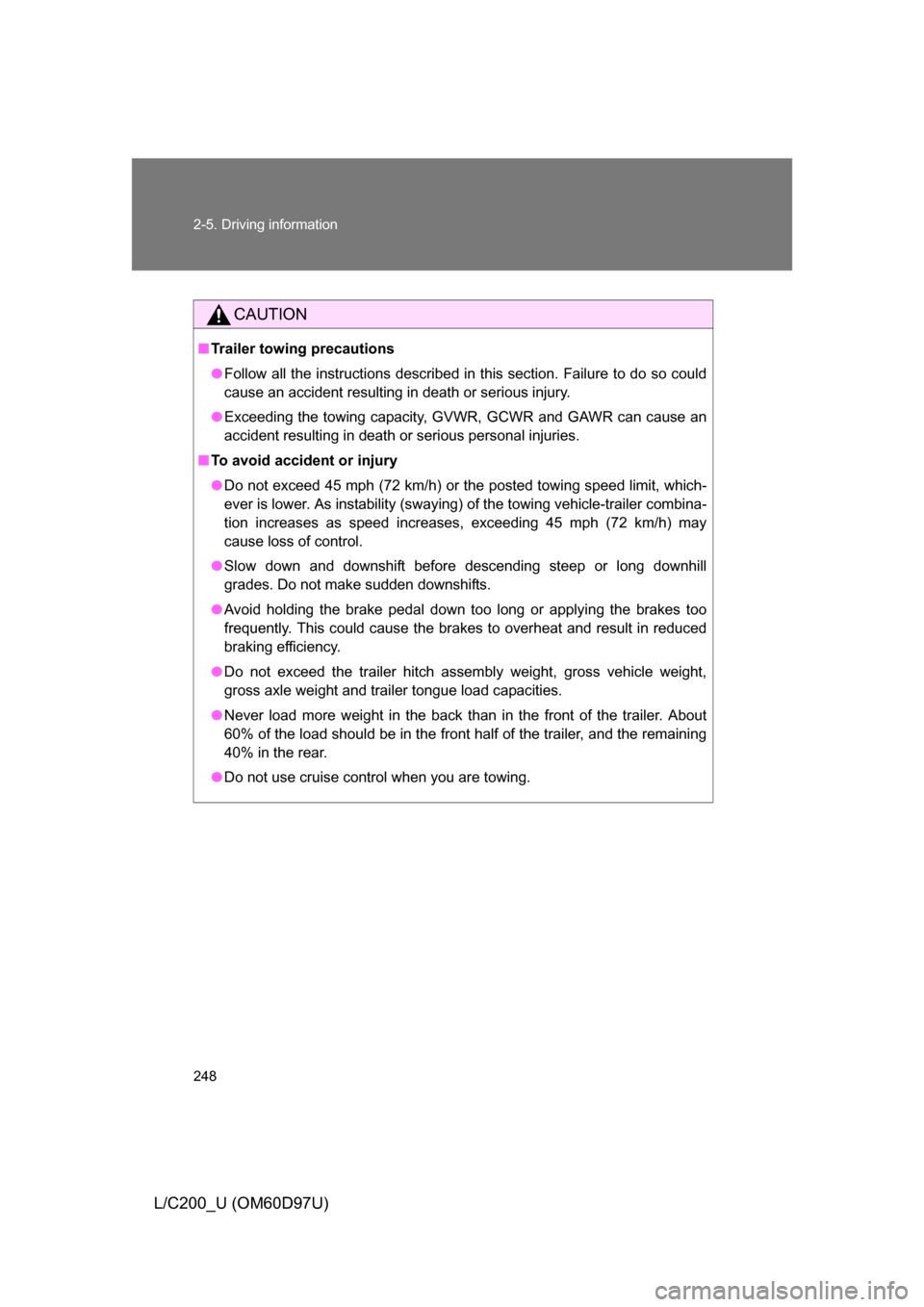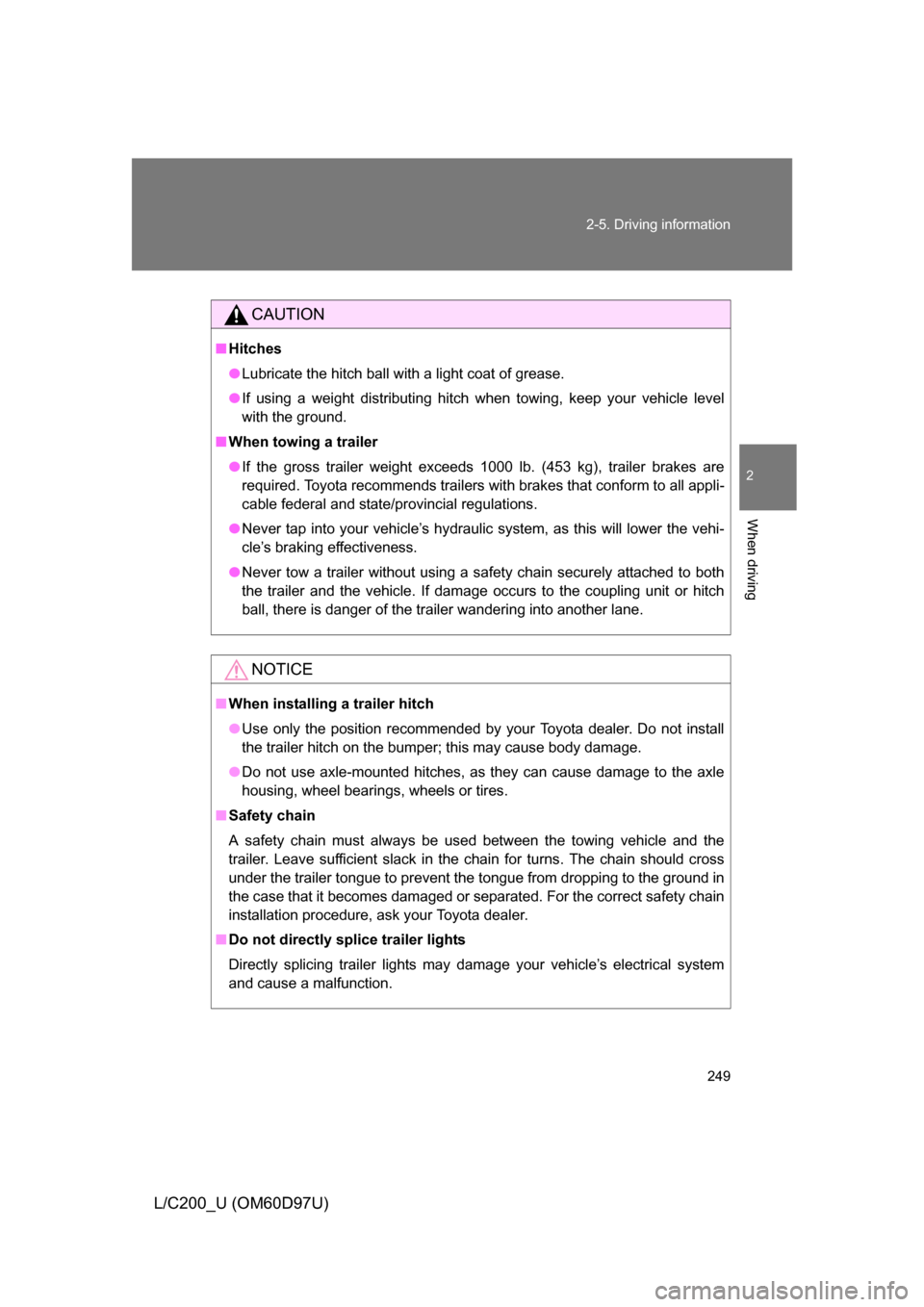Page 244 of 556

244 2-5. Driving information
L/C200_U (OM60D97U)
Trailer towing tipsYour vehicle will handle differently when towing a trailer. The 3 main
causes of vehicle-trailer accidents are driver error, excessive speed
and improper trailer loading. Keep the following in mind when towing.
● Before starting out, check the trailer lights and the vehicle-trailer
connections. Recheck after driving a short distance.
● Practice turning, stopping and reve rsing with the trailer attached in
an area away from traffic until you become accustomed to the feel
of the vehicle.
● Reversing with a trailer attached is difficult and requires practice.
Grip the bottom of the steering wheel and move your hand to the
left to move the trailer to the left. Move your hand to the right to
move the trailer to right. (This is generally opposite to reversing
without a trailer attached.) Avoid sharp or prolonged turning. Have
someone guide you when reversing to reduce the risk of an acci-
dent.
● As stopping distance is increased when towing a trailer, vehicle-to
vehicle distance should be increased. For each 10 mph (16 km/h)
of speed, allow at least o ne vehicle and trailer length.
● Avoid sudden braking as you may skid, resulting in jackknifing and
loss of control. This is especiall y true on wet or slippery surfaces.
● Avoid jerky starts or sudden acceleration.
● Avoid jerky steering and sharp turns, and slow down before mak-
ing turns.
Page 247 of 556

247
2-5. Driving information
2
When driving
L/C200_U (OM60D97U)
■
Before towing
Check that the following conditions are met:
● The vehicle’s tires are properly inflated.
● Trailer tires are inflated according to the trailer manufacturer’s recom-
mendation.
● All trailer lights work.
● All lights work each time you connect them.
● The trailer ball is set up at the proper height for the coupler on the t\
railer.
● The vehicle remains level when a loaded or unloaded trailer is hitched.
Do not drive if the vehicle is not level, and check for improper tongue
load, overloading, worn suspension, or other possible causes.
● The trailer cargo is securely loaded.
● The rear view mirrors conform to all applicable federal, state/provincial or
local regulations. If they do not, install rear view mirrors appropriate for
towing purposes.
■ Break-in schedule
Toyota recommends that you do not use a new vehicle or a vehicle with any
new power train components (engine, transmission, differential, wheel bear-
ings, etc.) to tow a trailer for the first 500 miles (800 km) of driving.
■ Maintenance
● If you tow a trailer, your vehicle will require more frequent maintenance
due to the additional load. (See “Scheduled Maintenance Guide” or
“Owner’s Manual Supplement”.)
● Retighten the fixing bolts of the towing ball after approximately 600 miles
(1000 km) of trailer towing.
Page 248 of 556

248 2-5. Driving information
L/C200_U (OM60D97U)
CAUTION
■Trailer towing precautions
● Follow all the instructions described in this section. Failure to do so could
cause an accident resulting in death or serious injury.
● Exceeding the towing capacity, GVWR, GCWR and GAWR can cause an
accident resulting in death or serious personal injuries.
■ To avoid accident or injury
● Do not exceed 45 mph (72 km/h) or the posted towing speed limit, which-
ever is lower. As instability (swaying) of the towing vehicle-trailer combina-
tion increases as speed increases, exceeding 45 mph (72 km/h) may
cause loss of control.
● Slow down and downshift before descending steep or long downhill
grades. Do not make sudden downshifts.
● Avoid holding the brake pedal down too long or applying the brakes too
frequently. This could cause the brakes to overheat and result in reduced
braking efficiency.
● Do not exceed the trailer hitch assembly weight, gross vehicle weight,
gross axle weight and trailer tongue load capacities.
● Never load more weight in the back than in the front of the trailer. About
60% of the load should be in the front half of the trailer, and the remaining
40% in the rear.
● Do not use cruise control when you are towing.
Page 249 of 556

249
2-5. Driving information
2
When driving
L/C200_U (OM60D97U)
CAUTION
■
Hitches
● Lubricate the hitch ball with a light coat of grease.
● If using a weight distributing hitch when towing, keep your vehicle level
with the ground.
■ When towing a trailer
● If the gross trailer weight exceeds 1000 lb. (453 kg), trailer brakes are
required. Toyota recommends trailers wi th brakes that conform to all appli-
cable federal and state/provincial regulations.
● Never tap into your vehicle’s hydraulic system, as this will lower the vehi-
cle’s braking effectiveness.
● Never tow a trailer without using a safety chain securely attached to both
the trailer and the vehicle. If damage occurs to the coupling unit or hitch
ball, there is danger of the trailer wandering into another lane.
NOTICE
■When installing a trailer hitch
● Use only the position recommended by your Toyota dealer. Do not install
the trailer hitch on the bumper; this may cause body damage.
● Do not use axle-mounted hitches, as they can cause damage to the axle
housing, wheel bearings, wheels or tires.
■ Safety chain
A safety chain must always be used between the towing vehicle and the
trailer. Leave sufficient slack in the chain for turns. The chain should cross
under the trailer tongue to prevent the tongue from dropping to the ground in
the case that it becomes damaged or separated. For the correct safety chain
installation procedure, ask your Toyota dealer.
■ Do not directly splice trailer lights
Directly splicing trailer lights may damage your vehicle’s electrical system
and cause a malfunction.
Page 250 of 556
250
2-5. Driving information
L/C200_U (OM60D97U)
Dinghy towing
NOTICE
■To avoid serious damage to your vehicle
Do not tow your vehicle with four wheels on the ground.
Your vehicle is not designed to be dinghy towed (with 4 wheels
on the ground) behind a motor home.
Page 347 of 556
347
3-5. Using the
storage features
3
Interior features
L/C200_U (OM60D97U)For second seats
For third seats
ITY34C024
NOTICE
■
Items that should not be stowed in the bottle holders
Put the cap on before stowing a bottle. Do not place open bottles in the bot-
tle holders, or glasses and paper cups containing liquid. The contents may
spill and glasses may break.
Bottle holders
Page 430 of 556
430 4-3. Do-it-yourself maintenance
L/C200_U (OM60D97U)
Fuse layout and amperage ratings■ Engine compartment
FuseAmpereCircuit
1A/F15 A
A/F heater
2HORN10 AHorn
3EFI MAIN25 A
EFI, A/F heater
4IG2 MAIN 30 AInjector, ignition, meter
5RR A/C50 ANo circuit
6SEAT-A/C LH25 A
No circuit
7RR S/HTR20 ARear seat heater
8DEICER20 AWindshield wiper de-icer
9CDS FAN25 A
Condenser fan
10TOW TAIL30 ATowing tail
11RR P/SEAT30 ANo circuit
12ALT-CDS10 A
Alternator condenser
13FR FOG15 AFront fog lights
14SECURITY5 ASecurity horn
15SEAT-A/C RH25 A No circuit
Page 431 of 556
431
4-3. Do-it-yourself maintenance
4
Maintenance and care
L/C200_U (OM60D97U)
16STOP15 A
Stoplights, high mounted stop-
light, brake controller, towing
converter, ABS, VSC, main
body ECU, EFI
17TOW BRK30 A
Brake controler
18RR AUTO A/C50 ARear blower control
19PTC-150 APTC heater
20PTC-250 A
PTC heater
21PTC-350 APTC heater
22RH-J/B40 ANo circuit
23SUB BATT40 A
To w i n g
24VGRS40 ANo circuit
25H-LP CLN30 AHeadlight cleaner
26DEFOG30 A
Rear window defogger
27AHC60 ANo circuit
28HTR50 ABlower controller
29PBD30 A
No circuit
30LH-J/B150 A Main body ECU
31ALT180 ANo circuit
32A/PUMP NO.150 A
AI DRIVER
33A/PUMP NO.250 AAI DRIVER2
34MAIN40 AHeadlight, daytime running
light system
35ABS150 A
ABS
36ABS230 A
ABS
37ST30 AStarter system
38IMB7.5 A ID code box, smart key sys-
tem, GBS
39AM25 A
Main body ECU
40DOME27.5 A
Vanity lights, overhead module
FuseAmpereCircuit